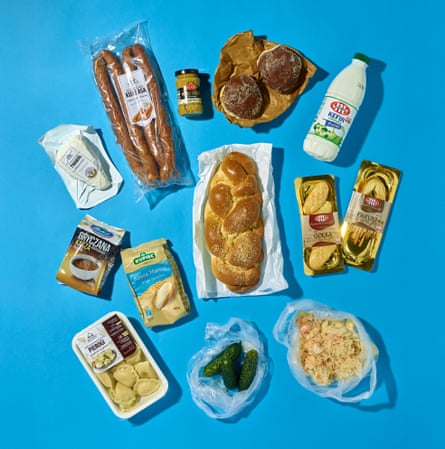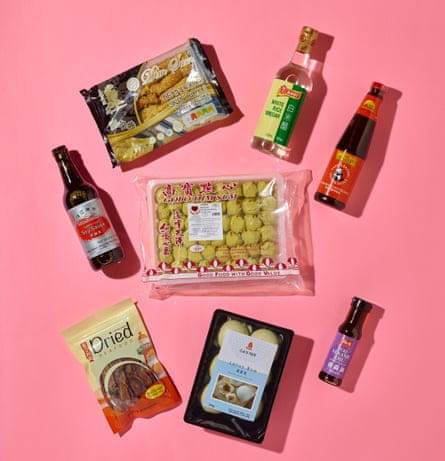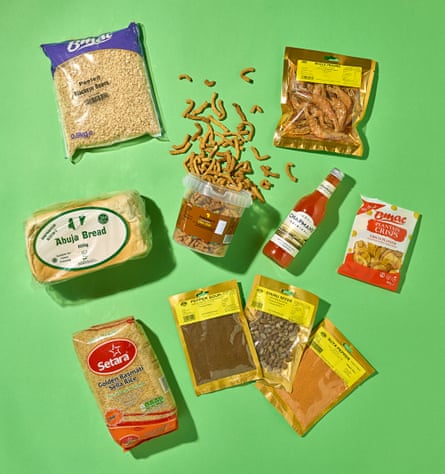‘This place is like a home away from home – it has everything I need’
Noor Murad, chef and author of Lugma, on Phoenicia, Kentish Town, London (picture above)
This is where I go for my big Middle Eastern shop, and I can’t shout out about them enough. When I first moved to London from Bahrain I was so homesick, but this place is like a home away from home. It has everything I need.
I always buy Dina Lebanese pitta bread, which is called khobez lebnani. They’re the thin, wide ones that are perfect for frying for fattoush salad. It’s also the bread you want for shawarma or tahdig (a Persian rice dish). I always keep some in my freezer.
They have really good za’atar; it’s a beautiful vibrant green, and I keep it in the freezer so it stays that way. It’s powdered, so you don’t have to defrost it. I use it to make za’atar pitta chips: spread the Lebanese pitta bread with olive oil and za’atar, and bake it. Break it up into shards to eat with dips or sprinkle it on salads, on fish, on eggs …
The Basra date syrup, which is Iraqi, is just so good. I use it the way people use honey or maple syrup: on porridge or on toast with tahini. Last Christmas, I used it in a sticky toffee pudding instead of treacle and it worked really well – it was less sickly.
I also get wheat vermicelli noodles here, which sometimes come broken, but often come in bundles that you break up yourself. I use them in soups and in a traditional Bahraini breakfast dish called balaleet, which is sweet noodles with salty eggs, scrambled or as an omelette. People have a ridiculously sweet tooth back home, so I do reduce the sugar.
They have a whole marinated olive buffet, and I love it so much. Scoop them up and take them home to have in the fridge for a snack.
There are loads of delicious hot sauces here, but there’s a brand called Crystal, which I like. It’s not spicy, it’s really vinegary. It’s the hot sauce we have back home, and you put it in a wrap with cheese spread, spring onions, sometimes crisps, and just roll it up.
I love anything with acidity, so I always have sumac to sprinkle on labneh (strained yoghurt), chicken or salads. It’s almost like salt and pepper. If you’re shopping in a supermarket, I quite like Rajah and East End spices, because you get more bang for your buck. I toast and grind the spices myself, so I buy them whole.
I really like the frozen veggies: frozen broad beans, which are sometimes hard to get; molokhia, a green that has an okra-y consistency; and they sell okra (the short, chubby ones you use in stew). What’s also good is that they have already been trimmed.

‘The smell of fermenting food and burning incense is quite spiritual’
Julie Lin, author of Sama Sama and co-founder of GaGa, Glasgow, on Isan Thai, Glasgow
I didn’t realise how essential SeeWoo in Springburn, Glasgow, was to me, and for bringing the Asian community together, until it closed. Then this lovely little shop Isan Thai opened in the West End – they have amazing ingredients I haven’t seen in Glasgow in my 10 to 15 years of cooking. I love it so much, and they have incense sticks burning, which reminds me of walking into shops in Malaysia. That smell of fermented foods amid the smoke of burning incense – it’s quite a spiritual experience.
I always get fresh ho fun noodles, which are the thick rice ones perfect for char kway teow (stir-fried prawns with noodles). Having fresh noodles makes a big difference, but they’re normally quite difficult to find. Here, they mix up the brands quite a lot.
I’m always delighted that I can get kangkong, AKA Chinese morning glory, here. It’s amazing water spinach that absorbs fermented chilli and shrimp so well.
They have a good stock of fresh pandan leaves, so I always pick some up. I’ll also buy a bottle of pandan essence for making chiffon cake, because, as much as I use the natural colour from the fresh leaves, sometimes it needs a helping hand. I’ll use it for making kaya (coconut) jam from scratch, which is beautiful. You can also get frozen pandan leaves, as well as frozen lime leaves.
I love salted plums, and I use them to make asam boi, an amazing sour drink that’s also a little bit salty.
They make their own salad dressings with red bird’s-eye chillies and that balance of palm sugar, fish sauce and lime juice. Another thing I keep up my sleeve is their curry paste; people don’t always have time to make it from scratch, and they have some good own-brand ones. Tean’s Gourmet do a good chicken curry paste and laksa paste; they’re super oily.
There’s a fun range of Asian crackers and crisps, such as shrimp, which I love. But for a snack I might get their papaya salad, or occasionally they have a gorgeous pandan chiffon cake.
There’s a good range of shell-on and shell-off prawns. I get shell-on ones to make a take on Singapore butter prawns, which uses a cereal you can’t get here but Quaker golden syrup oats are a good substitute.
Supermarket own-brand rice is not great, instead, go to the world food section and pick up a 2kg bag, which ends up cheaper. Using Thai rice, such as Green Dragon or Royal Umbrella, makes a real difference.

‘I buy sauerkraut from the big box fermenting on the floor rather than jars’
Zuza Zak, author of Pierogi: Over 50 Recipes to Create Perfect Polish Dumplings, on
My Daily Bread, Eastbourne, East Sussex, and Klos Deli, Lewisham, London
When I lived in London, my favourite Polish shop was Klos, which means a sheaf of wheat. It’s fantastic and I miss it; it’s very well stocked with beautifully sourced products – anything you pick up there will be good quality. Now, in Eastbourne, I go to My Daily Bread, which is a bakery with sporadic opening times. They have a refrigerator section where they sell nice cold cuts, but they also have grains.
You’ll find all kinds of bread including chalka, a traditional plaited loaf, and at Easter you can order a traditional bread bowl. They also make nice paczki, which are Polish doughnuts, and buns.
I buy my cold cutshere. I get a big pack of smoked country sausages to put on sticks and cook over the fire. My favourite brand is Bacowka.
Twaróg, which is a fresh curd cheese, is great for a pierogi filling, or as part of a dumpling mix. It’s a necessity. Smoked cheeses, are a nice snack. My girls love them, too, and you can even get smoked cheese strings. We eat the cheese on the way back from the shops.
Klos sometimes has homemade pierogi behind the counter. They sell out very quickly, but you can call on the day to find out if they have any. I make my own – I enjoy the process – but I sometimes buy them if they’re on offer, just to see what they’re like. Everyone has their own way of making pierogi.
We eat ogórki kiszone, which are gherkins in brine (as opposed to vinegar) with cold cuts – and if you’re buying meat from Klos, where there’s an entire counter, ask what they recommend, because they all have their favourites. For a traditional Polish snack, get good-quality lard and spread it on dark bread with a little salt on top and the gherkin on the side. If you go to a traditional Polish restaurant, you’ll often be given that before your meal.
I always buy sauerkraut, but from the big box fermenting on the floor rather than in jars. They do have some lovely jars there, but the important thing is to make sure there are no preservatives. Klos and Bacowka make a lot of condiments, such as beetroot and horseradish, as well as mushrooms in vinegar, to have with cold cuts. There’s also sarepska mustard, which is a very mild mustard flavoured with tarragon – it tastes of Poland.
Then there are grains, such as kasha, toasted or roasted buckwheat groats, which has a specific flavour. We often have this as part of our Sunday meal – if you’re having meat with some kind of sauce, or mushrooms, it gives it a very eastern European flavour. I’ll also get semolina to make porridge.
Kefir is another essential. I’ll either drink it on its own or have it as an accompaniment to crispy fried potatoes and onions with a bit of dill. That’s a typical lunch for me.

‘My mum and dad used it for their restaurant … there is everything’
Kwoklyn Wan, author of Chinese Made Easy, on Tai Fat, Leicester
I’ve been going to this supermarket for years, and my mum and dad used it for their restaurant. It used to be called PKM – named after the founders, Peter, Kitty and Maureen – but now it’s called Tai Fat. They have everything I need on a day-to-day basis, as well as nice bits for a treat. If I’m doing a big shop and want to stock up on egg noodles or wontons, then I’ll go to Wing Yip in Birmingham.
I always get Pearl River’s light soy sauce – it’s a Chinese brand and my dad has always used it – I think we tend to follow what our parents use. It’s the salty one, which is used for seasoning.
Oyster sauce is a magic ingredient, because you can put it into soups, add it to stir-fries or vegetables, or use it to marinate meat, and it makes everything taste great. It’s packed with umami and it’s quite salty – like MSG without it being MSG. I use Lee Kum Kee oyster sauce. They are the inventors of it, although completely by accident: they were boiling up oysters and let them stew for too long and came up with oyster sauce.
Then, white rice vinegar for tenderising meat, for soups, for adding acidity to dishes to balance those salty, sweet and chilli notes. I get Amoy white rice vinegar, but it’s quite forgiving, so pick up any brand. I use Shaoxing rice wine in a lot of dishes, near the end of cooking, to add that funky, pungent, alcohol-y flavour. Because it’s fermented, it has quite a distinctive oriental flavour.
I must have sesame oil in, and we always use pure sesame oil, never blended, because it is inferior. Sesame oil is just to finish a dish off; to season it and give it that nice nutty flavour.
Then, for a snack, it’s dried cuttlefish, which we call Chinese chewing gum. It’s ready to eat and shredded, but takes for ever to chew. Also, Chinese peanut brittle, which has more peanuts than toffee, the reverse of the British stuff. It’s one of my treats. We also always pick up a packet of fresh mochi (rice cakes) filled with peanut sugar. Great for your belly, not so good for your waistline.
And I get frozen lotus buns for my daughter: just pop them in a steamer, they’ll puff up, and you’ve got lovely, white, soft, steamed buns with lotus paste in the middle. I’m quite lazy when I’m cooking for myself, so I tend to pick up pre-made king prawn wontons from the freezer section, too.

‘It stocks unfamiliar fruit and vegetables just waiting to be discovered’
Asma Khan, author of Monsoon and founder of Darjeeling Express, London, on Fruity Fresh, Wembley
This has been a cornerstone of the vibrant south Asian community since the 1970s. It offers an extensive selection of Indian groceries, along with an impressive variety of fresh fruit and vegetables. What makes it truly special, though, is that it stocks everything you could possibly need, including unique fruit and vegetables that may be unfamiliar but are waiting to be discovered.
From mild Kashmiri chillies to intensely fiery naga chillies (ghost pepper), dried chillies add layers of heat and depth to dishes. They are essential for tempering dals and infusing meat and vegetable dishes with a complex chilli flavour. They can even be used in sweet dishes, like a chilli and chocolate barfi.
Jaggery is an unrefined sugar with a deep, malty flavour and rich molasses notes; it’s perfect for balancing chutneys and makes a wonderful natural sweetener for chai.
I try to resist the temptation of calculating the exchange rate and comparing prices with India, because Parle-G biscuits dipped in chai is more than a snack – it’s a taste of home, a moment of nostalgia.
Confusingly, many recipes use cinnamon and cassia bark interchangeably. But the heavier and woodier cassia bark adds a deeply aromatic flavour to savoury dishes and can easily be fished out after cooking.
Used more like a spice than a herb, dried fenugreek leaves (kasoori methi) impart a warm and slightly bitter smokiness to dishes. At my restaurant, it’s an essential ingredient in the base of the gravy in our methi chicken.
In Bengal, almost everything deep‑fried, breaded or battered is served with ketchup. It’s often spiced up with chillies or other seasonings for an extra kick, and I always get Kissan’s fresh tomato ketchup.
Dal puri are flavour-packed, stuffed flatbreads, and a beloved, comforting street food classic. Having them in the freezer means I can enjoy them when I need them, paired with chutneys or a cup of chai.
Most international food aisles in large supermarkets now carry a good selection of south Asian ingredients. One essential is lentils – they’re affordable and open the door to making nourishing dals from scratch.

‘If they don’t have something, they’ll help you source it’
Aji Akokomi, founder of Akoko and Akara, both in London, on Ades, Charlton and Plumstead
Pretty much everything we use at Akoko – the spices, the rice and, most importantly, the black-eyed beans – come from Ades. They have all the produce and ingredients you could want, sourced from Nigeria. We use African produce that can travel well. Also, if they don’t have something, they’ll help you source it.
Among the African community, we want our rice to be the best when it comes to cooking jollof. I use golden sella basmati rice – I get bags of it every week for the restaurant. For the best jollof, always thoroughly wash the rice a couple of times before cooking, and don’t parboil it – that can lead to the grains becoming mushy and overcooked. To reduce the risk of burning, cook it in the oven to prevent it catching on the bottom. And keep the spices traditional: back home we use scotch bonnet, ginger, garlic, white peppercorns, curry powder and dried thyme.
Black-eyed beans are very important, and Ades get the peeled ones in for me, which we use to make moin moin, a traditional Nigerian steamed bean pudding wrapped in banana leaf.
For home, I’ll get suya spice. I’ll then get some chicken from my local butcher and rub a mix of butter and the spice all over the meat. Add a little bit of salt and roast it – it’s so good.
Other spices I always get are penja pepper; ehuru, which is African nutmeg and our most used spice, particularly in desserts; and their pepper soup seasoning which is a mix of ehuru, uda (selim pepper), grains of paradise (a species of the ginger family), cloves, dried lime leaf and bay all pounded together.
I always pick up chin chin (a fried Nigerian snack) and crispy plantain chips to snack on, as well as a bottle of Nigerian Chapmans, Fanta or Maltina from the fridge, to remember home. I’ll also buy Nigerian (agege) bread, which I’ll eat in the car on the way home or to the restaurant.
I buy smoked prawns from here, which we use to make our own prawn powder, and also crayfish, which we then blitz with salt to give dishes that strong crayfish flavour.

.png) 6 hours ago
4
6 hours ago
4

















































